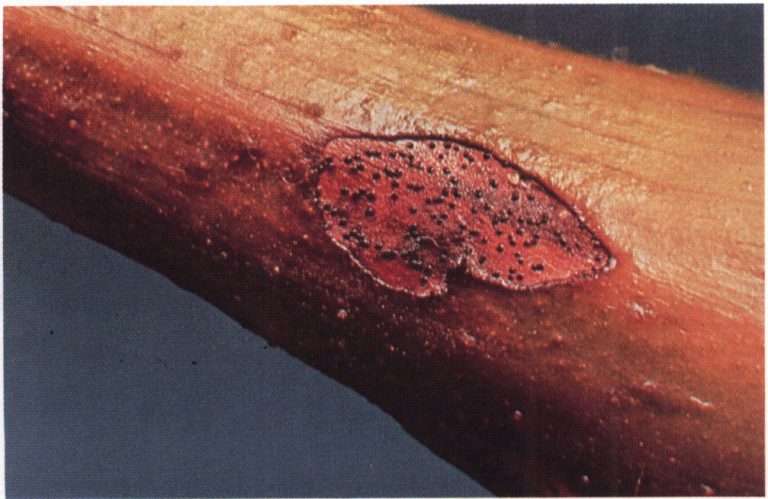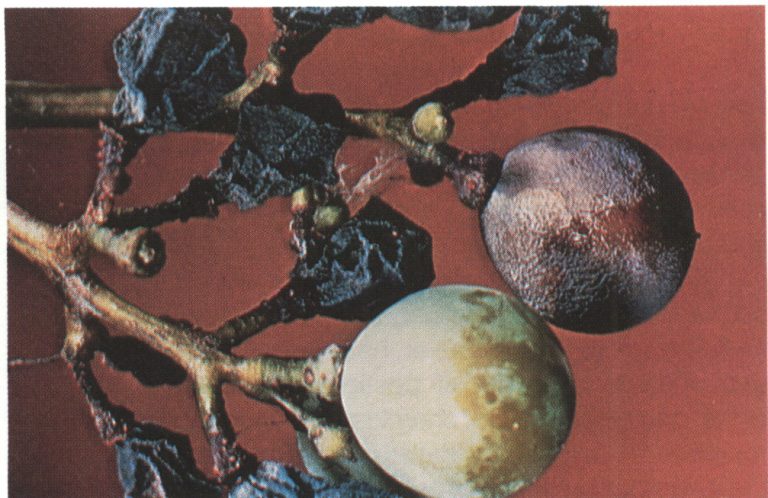Black Rot of Grapes
Grapes are increasingly being grown commercially and in home yards. With greater interest in grape culture, diseases, insects and weeds are becoming of more of a concern. The spread of disease-causing organisms is sometimes associated with the presence of certain insects and weeds. Therefore, homeowners and commercial growers alike should be aware of such relationships and practice integrated pest management (IPM).
IPM is the process of achieving optimal pest control in an economically and ecologically sound manner. Use of IPM makes disease control easier, helps reduce the need for and use of large amounts of pesticides, reduces production costs and helps prevent chemical contamination of the environment. It is suggested that all grape growers carefully study their vines for presence of pests and control them before they become major problems.
Black rot, a foliar and fruit disease of grapes (caused by the fungus Guignardia bidwellii), is considered to be the most serious disease of grapes in Oklahoma. The principal disease loss is the direct destruction of fruit. Some of this loss may occur early in the season through destruction of blossom clusters or when the fruits are just forming. Growers may not be aware of early losses. Older, larger fruits may also become infected. In this case, the appearance of the fruit bunch is affected as many fruits become rotten and shrivel into black mummies. Usually, loss of infected foliage is not severe and while infected stems weaken the plant, they rarely cause death.
Disease Symptoms and Disease Cycle
Foliage
All of the new growth can become infected during the growing season. On leaves, the black rot disease appears in late spring on the upper surface as definite necrotic (dead) spots, which are at first circular and tan with a red margin (Figure 1). Later, the spots are visible on both sides of the leaf. As the spots enlarge, their margins become black and the red spots turn brown. At this time the spots may be irregular in shape. After the spots cease growing, they may be about 1/4 inch in diameter. Also, small black dots, asexual fruiting structures, begin forming (Figure 2). As time passes, more fruiting structures appear and conidia (spores) are produced. These conidia infect newly formed tissues throughout the season during extended wet weather. Black rot lesions also occur on tendrils, leaf stems, veins, flowers, flower stems and shoots (Figure 3). These are not as readily visible as those on leaves.
Figure 1. Symptoms of early infection of grape leaves by the black-rot fungus.
Figure 2. Development of fruiting structures of the black-rot fungus in infection spots (lesions) on a leaf.
Figure 3. Development of fruiting structures of the black-rot fungus in a lesion on a leaf petiole.
Fruit
Infection spots (lesions) usually do not appear on fruits until after they are half grown. The first symptom is the appearance of very small whitish areas on developing green fruit. These are soon surrounded by a rapidly widening brown ring, giving a bird’s eye effect. As the fruit rots, black sexual fruiting bodies (perithecia) begin to form. Later, the rotted fruits become black, perithecia studded mummies (Figure 4). Mummies are easily dislodged but some may remain attached through the winter. After spring rains thoroughly soak the mummies, spore-bearing bodies (asci) in the perithecia forcibly release ascospores. Air movements carry ascospores to developing plant parts, which they infect under wet conditions. Some ascospores are also released during the summer when heavy rains occur and can infect tissues. Thus, there can be a continuous primary infection of tissues. The greatest numbers of infections, however, occur during the spring.
Figure 4. Shriveled, black, infected grapes (mummies) covered with sexual fruiting bodies of the black-rot fungus.
Black Rot Control
Sanitation and Cultural Practices
Pruning of vines removes much infected tissue, but the pruning action causes old fruit mummies to fall to the ground, thus providing them an advantageous environment to become wetted for long periods, thus aiding spore production. Removing mummies from the vineyard is helpful to prevent the spread of fungal spores. Thinning the canopy by pulling leaves and shoot thinning help to improve air-flow circulation, which reduces fungal disease pressure.
Resistant Cultivars (Varieties)
Many grape cultivars have some resistance but still require a few applications of recommended fungicide sprays during wet periods. Cultivars that have large fruits or mature early in the season are the most susceptible.
Chemical Control
Certain fungicides are effective for preventing black rot if they are applied beginning early in the spring when the young shoots are developing and spraying is timed to anticipate a rainy period. For additional details on the use of fungicides on grapes, read CR-6252, Commercial Grape Insect and Disease Control, available at any county Oklahoma State University Extension office on online at OSU Fact Sheets.
Favorable Conditions
Black Rot fungus primarily overwinters in grape mummy clusters. Spring rains and dew trigger release of spores that cause primary leaf and blossom infection. The optimum temperatures for fungal infections is 80 F and can happen in as little as six hours if leaves are wet.
Revised from a fact sheet prepared by Sharon von Broembsen and Phillip W. Pratt.




